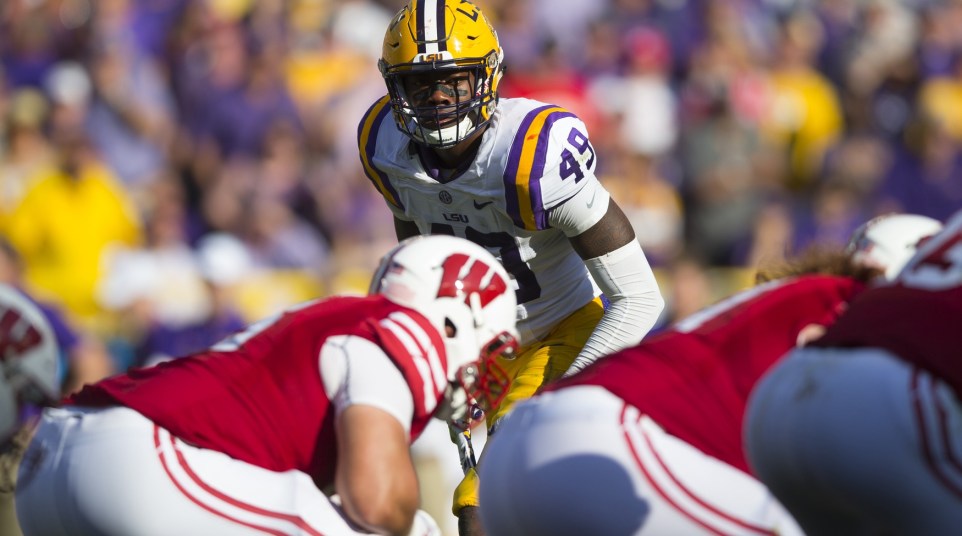
Whatever base defense it plays, Arden is the Key for LSU's hybrid front
BATON ROUGE, La. — The big news for LSU’s defense this year was that after years of being a 4-3 team going back to the Nick Saban era, new defensive coordinator Dave Aranda was going to transition the Tigers to a 3-4 front.
In Saturday’s 23-20 win over Mississippi State, the Tigers seemed to shift back to the 4-3 for much of the game, generating pressure on quarterback Nick Fitzgerald with outside linebacker Arden Key, a converted defensive end, getting into the three-point stance and coming after the quarterback on, seemingly, the majority of the plays.
“I’m more explosive out of my (three-point) stance with my hand in the dirt,” Key said prior to the Mississippi State game. ”
He was explosive against the Bulldogs, finishing with two quarterback sacks to give him an SEC-leading five for the season. He gets most of the pressure playing a defensive end technique out of a three-point stance, giving the Tigers a four-man front.
But don’t let that fool you. Just because Key is giving LSU a fourth defensive lineman doesn’t mean the Tigers are necessarily giving a 4-3 look, just a modified 3-4. Or maybe it is a 4-3.
I’ll explain.
In Aranda’s 3-4 scheme, the base scheme calls for him to play as a stand-up outside linebacker, which fits into his skill set well as a rather slender 6-foot-6, 238-pounder who is built more like, and moves with the fluidity of, a lean basketball forward rather than a bulky defensive lineman.
He’s able to drop into pass coverage and run sideline-to-sideline as a linebacker. But he makes his biggest plays as a pass-rusher, something he seems to do more and more of as the season progresses. And, as he said, he prefers doing that from a three-point stance.
He put the nail in the Bulldogs’ coffin on Saturday when, lined up wide but in the three-point stance, he ran down MSU quarterback Damian Williams for a game-clinching fourth-down sack late in the fourth quarter, forcing a fumble.
“We like him doing it!,” Miles said of Key’s play out of a defensive end technique. “We’re encouraged that he enjoyed it. It’s one of the things that you recruited him for, so we’ll look forward to giving him that opportunity. I think if you went back and saw the number of places that he rushed from, I think you could see that there’s an opportunity there for him to really show his skill. We’re for that.”
But when he’s the fourth lineman, does that even mean the Tigers are in a 4-3? To answer that, let’s look at how Aranda’s scheme evolved for Key’s talents.
“It started at practice,” Key said. “I’d get in the three-point stance when I knew I was going to rush and (defensive line coach Ed Orgeron) came in and told us that when we know we’re going to rush, get in the three-point stance, and he talked to (Aranda) and he liked it.”
So if one translates that correctly, originally, the Tigers were setting up on passing downs to be in a 3-4 look with Key rushing from an outside linebacker spot. It’s only for Key’s preference that Orgeron and Aranda thought it preferable to allow him to rush from a defensive end-type technique.
So is it a 4-3? Or a 3-4 with an outside linebacker doing something a little different?
And does it even matter what you call it?
LSU had six sacks of starting quarterback Nick Fitzgerald and Williams last Saturday, and they did it without help from blitzers. Key and defensive ends Lewis Neal (2.5 sacks) and Davon Godchaux (1.0) are all accomplished pass-rushers who were starters last season.
Even with a bulky run-stopper like Travonte Valentine in the new nose tackle position, the Tigers can generate pressure without needing help. Of the team’s 11 sacks, 8.5 are by Key, Neal and Godchaux.
“I couldn’t do it without them,” Key said. “You need all of the front four to create pressure.”
Was that a slip? Key, at the end of the day, still calls it a front four, as in four defensive linemen.
Whatever you want to call it, it’s working for Aranda and LSU.
